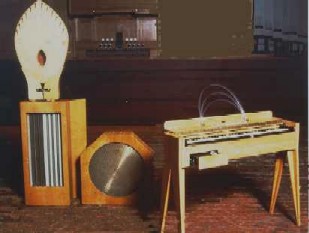
Image from http://www.klassiekemuziekgids.net/componisten/levidis.htm
The Ondes Martenot
is a monophonic electronic instrument
which was invented in 1928. Pitch is
controlled with the right hand by a
keyboard or ribbon, whilst sound intensity
and tone are controlled by switches
located in a drawer and operated by
the left hand. Ondes is French for "waves"
and Maurice Martenot (1898-1980) was
the Frenchman who invented the instrument.
Martenot was a cellist and scientist
whose interest in electronic sound was
primarily in its expressive musical
potential. About 370 instruments in
seven different versions were produced
in Martenot’s workshop, latterly by
his assistant Marcel Manière.
Production ceased in 1988 but a similar
instrument, the ondéa is on its
way.
The ondes is most likely
to be familiar from Messiaen’s Turangalîla
Symphony but Milhaud, Honegger, Varèse
and Boulez have all written music including
a part for it and the total repertoire
of about a thousand works also features
some film music. This disc features
a wide ranging selection played on ondes
Martenot number 343 by Thomas Bloch
and including five world premiere recordings
(the three works by Bloch and those
by Wisson and Redolfi). Only in Thomas
Bloch’s Formule is the ondes
played solo, elsewhere it is combined
with the orchestra, piano, percussion,
woodwind, vocals and other electronic
instruments. The other two works by
Thomas Bloch are for nine ondes and
played by his own Waves Orchestra. It
is not clear from the documentation
but I suspect this may be him playing
all nine parts.
The disc opens with
some Messiaen, appropriately since he
and his sister-in-law, Jeanne Loriod
(1928-2001 - a fine exponent of the
ondes), probably did more than anyone
to popularize the instrument. The Feuillet
inédits were put together by
the composer’s widow Yvonne Loriod and
published in 2001. No. 4 is a short
work, pastoral in feeling at the opening
but becoming increasingly ethereal.
After this Bloch’s Formule is
a rude awakening to some more menacing
sounds. This is described as a repetitive
toccata and was written as an encore
for one his recitals.
Bernard Wisson’s Kyriades
exists in several forms and is given
here as a concerto in three movements.
This is the most substantial work on
the disc, lasting 16 minutes. The first
and third movements are dark in feeling
with prominent percussion but the slow
movement brings light and lyricism from
the ondes.
Martinů’s
Fantaisie preceded the Wisson by over
half a century and is also quite substantial.
It was originally written for the theremin
(a related instrument introduced one
year before the ondes), piano, oboe
and string quartet but proved too difficult
to play on the theremin. Substitution
of the ondes was therefore authorized
by Martinů. This is an attractive
work, quite characteristic of
the composer and it provides a good
contrast with the more modern works
preceding and following it on the disc.
All the other works
are fairly short and the product of
recent years. Mare Teno and Nightmare
include voices and the latter also
has parts for bassoon, keyboards, percussion
and a phone answering machine. Perhaps
the most remarkable is Etienne Rolin’s
Space Forest Bound which has
an improvisatory quality. In the first
section, entitled Heterodyne,
it evokes images of outer space whilst
the finale, Creature Beat, lands
us back in an earthly jungle.
Throughout the disc
Thomas Bloch makes a good case for the
ondes and he demonstrates its full potential.
In the excellent booklet there is a
detailed essay on the instrument and
on the individual works but no room
for information about the performers.
A stimulating rather
than a relaxing disc. It gets full marks
for interest value and may be better
sampled rather than swallowed whole.
This is an essential purchase for those
interested in unusual instruments. Once
heard, the ondes is unforgettable.
Patrick C Waller

